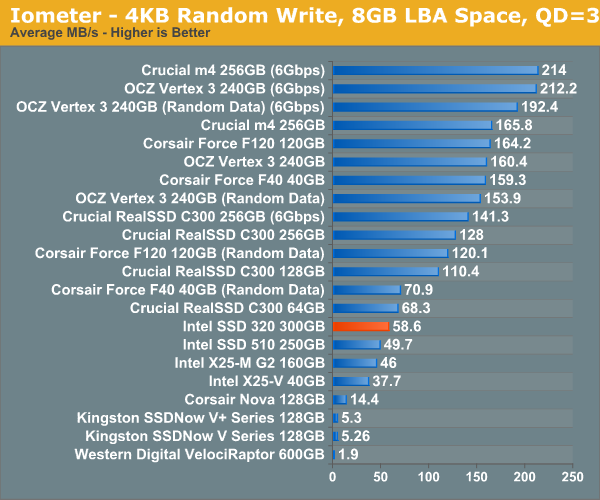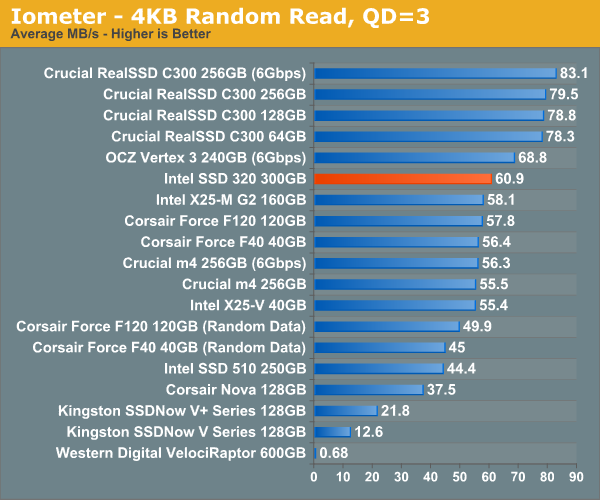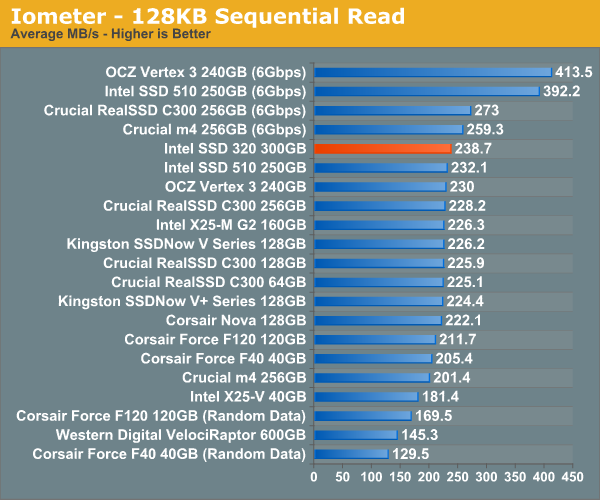The Intel SSD 320 Review: 25nm G3 is Finally Here
by Anand Lal Shimpi on March 28, 2011 11:08 AM EST- Posted in
- IT Computing
- Storage
- SSDs
- Intel
- Intel SSD 320
Random Read/Write Speed
The four corners of SSD performance are as follows: random read, random write, sequential read and sequential write speed. Random accesses are generally small in size, while sequential accesses tend to be larger and thus we have the four Iometer tests we use in all of our reviews.
Our first test writes 4KB in a completely random pattern over an 8GB space of the drive to simulate the sort of random access that you'd see on an OS drive (even this is more stressful than a normal desktop user would see). I perform three concurrent IOs and run the test for 3 minutes. The results reported are in average MB/s over the entire time. We use both standard pseudo randomly generated data for each write as well as fully random data to show you both the maximum and minimum performance offered by SandForce based drives in these tests. The average performance of SF drives will likely be somewhere in between the two values for each drive you see in the graphs. For an understanding of why this matters, read our original SandForce article.

Random write speed is improved compared to the 510 thanks to Intel's controller, but we're only looking at a marginal improvement compared to the original X25-M G2.
Many of you have asked for random write performance at higher queue depths. What I have below is our 4KB random write test performed at a queue depth of 32 instead of 3. While the vast majority of desktop usage models experience queue depths of 0 - 5, higher depths are possible in heavy I/O (and multi-user) workloads:


Random read performance has always been a strong point of Intel's controller and the 320 is no different. While we're not quite up to C300 levels, the 320 is definitely competitive here.
Sequential Read/Write Speed
To measure sequential performance I ran a 1 minute long 128KB sequential test over the entire span of the drive at a queue depth of 1. The results reported are in average MB/s over the entire test length.

Without a 6Gbps interface the 320's performance is severely limited. Compared to other 3Gbps drives the 320 is quite good here though.

Read performance is at the top of the chart for 3Gbps drives. I wonder how far Intel would've been able to push things if the 320 had a 6Gbps controller.










194 Comments
View All Comments
Drag0nFire - Monday, March 28, 2011 - link
I have read with interest the comments in previous SSD articles. Actually, though, I am specifically interested in the longevity characteristics of this drive being discussed today. I was surprised to see no mention in the article.If the longevity of the Intel SSD 320 has been discussed previously, I apologize for wasting your time.
Anand Lal Shimpi - Monday, March 28, 2011 - link
The 320 (as well as Crucial's m4) arrived while I was away at CTIA last week - I got back Friday morning. That gave me a minimal amount of time to get everything tested before today's NDA. As a result, about five pages got cut out of the 320 review - one of them talked about write amp and exactly what you're asking for. Soon :)Take care,
Anand
Drag0nFire - Tuesday, March 29, 2011 - link
Thanks so much. You guys are the best!Mr Perfect - Monday, March 28, 2011 - link
I'm surprised no one has mentioned the Crucial M4 (AKA C400?) numbers in the benchmarks. Is this old news, or did they just slip in there without anyone noticing. :)Termie - Monday, March 28, 2011 - link
Intel is sending around $530 300GB drives to bench against the current crop of $200 120GB drives. As Anand rightly pointed out, the 300GB drive has completely different specs than the smaller drives. Unlike SandForce, which seems to provide similar performance across sizes, Intel's new drives cannot substitute for each other in performance.I'm guessing very few people will actually buy a $530 drive at this point (even $450 was a hard sell a year ago for the 160GB G2). There are just too many $200 alternatives, and these probably significantly outperform Intel's $200 G3.
crimson117 - Monday, March 28, 2011 - link
I wish the article was a little more clear about this - the first comparison mentioned is "Intel SSD 320 300GB vs. Corsair Force F120 [120GB]" and Anand immediately concludes that it proves the Intel Controller is faster.crimson117 - Monday, March 28, 2011 - link
Note Ryan's comment in another thread:"Both the 120GB Vertex 2 and 300GB i320 are fully populated - each has all of their NAND channels in use. Intel does have a lane count advantage (10 vs. 8), but that's a design difference rather than how the SSD is populated. Thus on an architectural level it's fair to compare the controllers, as we're looking at the performance of both when they're fully populated and the architecture is not unnecessarily bottlenecked.
"Now at equal capacities this wouldn't necessarily be the case. Intel did not provide us with a smaller SSD, which is why Anand said "We also don't have a good idea of how much slower the smaller capacity drives perform in our benchmarks at this point.". It's safe to assume a 120GB i320 won't be fully populated and that it will have lower performance as a result. How much? We don't know."
tonyn84 - Monday, March 28, 2011 - link
Man, I was waiting for these to come out before trying to pick up a larger drive but there's no cost benefit. The 256gb C300 is starting to look very good, going to keep an eye on those prices now.crimson117 - Monday, March 28, 2011 - link
Anand,"all indications pointed to it being faster than drives based on SandForce's SF-1200 controller. And it is..."
Is it really fair to put a 300GB Intel 320 drive against a 120GB SF-1200 drive and conclude the Intel's new controller is faster?
My understanding is that larger SSD's generally perform faster than smaller SSD's, particularly in Write operations, because they have more NAND to write across at once.
How would the 120GB model Intel 320 stand up to a Vertex 2 120GB, when it doesn't have the NAND chip quantity advantage?
Thanks,
crimson117
crimson117 - Monday, March 28, 2011 - link
EDIT: I just saw this on the final page."We also don't have a good idea of how much slower the smaller capacity drives perform in our benchmarks at this point."
That should be mentioned as a caveat on the first page's "Intel SSD 320 300GB vs. Corsair Force F120 [120GB]" comparison chart (if you even keep that chart at all). That chart really doesn't provide a useful comparison when you consider the size advantage of the Intel drive.